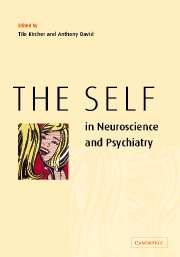Book contents
- Frontmatter
- Contents
- List of contributors
- Introduction: the self and neuroscience
- Part I Conceptual background
- Part II Cognitive and neurosciences
- 5 The multiplicity of consciousness and the emergence of the self
- 6 Asynchrony, implicational meaning and the experience of self in schizophrenia
- 7 Self-awareness, social intelligence and schizophrenia
- 8 The neural correlates of self-awareness and self-recognition
- 9 Autonoetic consciousness
- 10 The neural nature of the core SELF: implications for understanding schizophrenia
- Part III Disturbances of the self: the case of schizophrenia
- 11 Self and schizophrenia: a phenomenological perspective
- 12 Self-disturbance in schizophrenia: hyperreflexivity and diminished self-affection
- 13 The self-experience of schizophrenics
- 14 The paranoid self
- 15 Schizophrenia and the narrative self
- 16 Self-narrative in schizophrenia
- 17 Schizophrenia as disturbance of the self-construct
- 18 Action recognition in normal and schizophrenic subjects
- 19 Disorders of self-monitoring and the symptoms of schizophrenia
- 20 Hearing voices or hearing the self in disguise? Revealing the neural correlates of auditory hallucinations in schizophrenia
- 21 The cognitive neuroscience of agency in schizophrenia
- 22 Self-consciousness: an integrative approach from philosophy, psychopathology and the neurosciences
- References
20 - Hearing voices or hearing the self in disguise? Revealing the neural correlates of auditory hallucinations in schizophrenia
from Part III - Disturbances of the self: the case of schizophrenia
Published online by Cambridge University Press: 18 December 2009
- Frontmatter
- Contents
- List of contributors
- Introduction: the self and neuroscience
- Part I Conceptual background
- Part II Cognitive and neurosciences
- 5 The multiplicity of consciousness and the emergence of the self
- 6 Asynchrony, implicational meaning and the experience of self in schizophrenia
- 7 Self-awareness, social intelligence and schizophrenia
- 8 The neural correlates of self-awareness and self-recognition
- 9 Autonoetic consciousness
- 10 The neural nature of the core SELF: implications for understanding schizophrenia
- Part III Disturbances of the self: the case of schizophrenia
- 11 Self and schizophrenia: a phenomenological perspective
- 12 Self-disturbance in schizophrenia: hyperreflexivity and diminished self-affection
- 13 The self-experience of schizophrenics
- 14 The paranoid self
- 15 Schizophrenia and the narrative self
- 16 Self-narrative in schizophrenia
- 17 Schizophrenia as disturbance of the self-construct
- 18 Action recognition in normal and schizophrenic subjects
- 19 Disorders of self-monitoring and the symptoms of schizophrenia
- 20 Hearing voices or hearing the self in disguise? Revealing the neural correlates of auditory hallucinations in schizophrenia
- 21 The cognitive neuroscience of agency in schizophrenia
- 22 Self-consciousness: an integrative approach from philosophy, psychopathology and the neurosciences
- References
Summary
Abstract
In this chapter we have explored the model of impaired self-monitoring which has been proposed to underlie the pathophysiology of auditory hallucinations and delusions in schizophrenia. We begin with an overview of the model from its beginnings in sensorimotor literature to its elaboration by Chris Frith. We then review the neuropsychological support and functional neuroimaging data of verbal self-monitoring in healthy individuals, inner speech and auditory hallucinations. A summary of our most recent data of overt verbal self-monitoring as measured by functional magnetic resonance imaging in healthy individuals as well as in patients with schizophrenia, both acutely psychotic and in remission, follows. We complete the chapter with a proposal for the neural circuitry involved in self-monitoring based on our behavioural and neuroimaging data and proposals for future research.
Introduction
That we recognize our thoughts, even the most bizarre and unpleasant ones, as arising from our own minds is a phenomenon which we take for granted. Associated with this is our ability to distinguish ourselves from others at a basic physical level and in terms of more nebulous concepts like ideas, beliefs and values. Yet most of us can also recall moments, such as upon wakening, when we've wondered if an experience was real or a dream. The experience of psychosis may represent an extreme example of this uncertainty. A hallucination, one of the cardinal features of psychosis, is a perception which occurs in the absence of a corresponding sensory stimulus.
- Type
- Chapter
- Information
- The Self in Neuroscience and Psychiatry , pp. 425 - 435Publisher: Cambridge University PressPrint publication year: 2003
References
- 1
- Cited by



